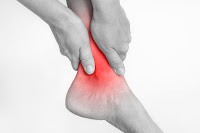Sport's Dreaded "High Ankle Sprain"
Connecting the two bones of the lower leg & ankle (the tibia and fibula) are four ligaments called the syndesmotic ligaments. A high ankle sprain occurs with damage to one or more of these ligaments. This injury gets its common name because these ligaments are further up the leg than those damaged in other ankle sprain injuries.
Causes
- Injuries of the syndesmosis are commonly associated with an ankle fracture where one or more of these ligaments is partially or completely ruptured (torn).
- Without fractures, sprains can occur when the foot is in an up position relative to the ankle and the leg rotates externally (outward). High ankle sprains may often follow, especially in cases where continued rotation causes a complete tear of the ligaments.
- Being hit or kicked in the outside of the lower leg in soccer, football or other sports may cause injury to the syndesmosis. In these cases, other injuries along the inside of the ankle must be ruled out before diagnosing a high ankle sprain.
Signs & Symptoms
- For acute injuries, swelling and pinpoint tenderness along the syndesmosis is often seen. Squeezing the lower leg muscles from side to side (the "squeeze test") may also cause pain in the area.
- Moving the foot up and rotating it to the outside will also cause pain along the syndesmosis (low ankle sprains cause pain when the foot points down and in, contrasting the difference between the two).
- May be associated with swelling along the inside or outside of the ankle when other injuries are suspected.
- Difficulty bearing weight for moderate to severe injuries is extremely common. For more mild injuries, the patient may be able to bear weight.
X-Ray
X-rays of the ankle are necessary to rule out a separation of the tibia and fibula, especially in injuries that cause disruption of all four ligaments. However, x-rays may not be able to completely evaluate an injury to the syndesmosis when some of the four ligaments are intact. X-rays will also help to rule out any bone injury that may be associated with injuries to the syndesmosis. Stress testing may be performed under fluoroscopy, which allows us to move the foot in a certain position to try to produce a separation between the two ankle bones.
MRI
MRIs are more definitive for syndesmotic injuries. Ruptures of one or more of the ligaments are easily seen on the axial images. MRIs are also able to evaluate any abnormal position of the syndesmosis, which could contribute to long-term problems.
CT Scans
CT Scans can be used to evaluate the position of the tibia relative to the fibula. They are most often used in cases of this injury.
Treatment
 |
| Example of an ankle sprain where complete rupture of the syndesmosis resulted in surgery. |
Complete ruptures of the syndesmosis, where the tibia and fibula are shown to be separated need to be addressed surgically. Fractures to the bones must always be ruled out first. Procedures are perfomed on an outpatient basis under a twilight or general anesthetic. One or two screws are placed from the fibula into the tibia to reduce the bone separation and allow healing of the ligaments. Immobilization in a boot or cast may be necessary for 4-6 weeks. However, using crutches to minimize weight-bearing activity is necessary for up to twelve weeks. Screws may or may not be removed for three months. We often replace the screws with large caliber sutures that maintain the reduction of the syndesmosis and allow normal motion of the ankle joint. At times these large sutures (tightropes) may be used in lieu of screws to prevent us from doing secondary surgical procedures. The degree of injury often dictates whether we use screws or suture buttons to repair the syndesmosis.
Prognosis
- For mild injuries to the syndesmosis, conservative care produces an excellent long-term outcome. A return to sports within 6-8 weeks usually follows conservative care. Occasionally an impingement may develop in the ankle, necessitating a small cortisone shot to restore better motion to the ankle. A full recovery is expected in most cases.
- When surgery is performed for moderate to severe injuries, the prognosis is excellent following a screw or suture button reduction of the syndesmosis. Return to sports may take 4-6 months. It is expected that our patients will continue to improve for 12-18 months following any surgical procedure. It is imperative to reduce the syndesmosis accurately to prevent any malalignment.
Use our online scheduler to book your appointment! If you have a busy schedule during the week, we are open Saturdays by appointment only in our recently redone Plantation office.
Click here for pre- and post-surgery x-ray imaging and more information from Dr. Robert Sheinberg, DPM.






